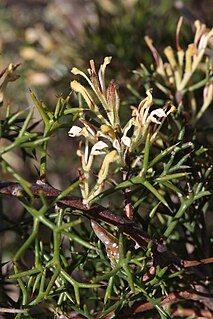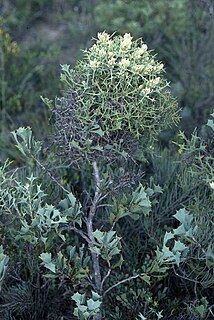
Hakea bucculenta, commonly known as red pokers, is a large shrub in the family Proteaceae endemic to Western Australia. A spectacular ornamental shrub with red or orange flowers that appear in rod-like blooms in leaf axils for an extended period from May to November.

Hakea scoparia is a species of flowering plant in the family Proteaceae and is endemic to the south-west of Western Australia where it grows in shrubland. It is a shrub with ascending branches, terete leaves and clusters of cream to pinkish flowers in leaf axils from June to September.

Hakea corymbosa, commonly known as the cauliflower hakea is a plant of the family Proteaceae which is endemic to the south-west of Western Australia. An attractive extremely prickly bush with sweetly scented yellowish flowers. The nectar rich blooms and dense form provides a good habitat for wildlife.

Hakea teretifolia, commonly known as the dagger hakea, is a species of woody shrub of the family Proteaceae and is common on heathlands in coastal eastern Australia from northern New South Wales through to Victoria and Tasmania. A very prickly shrub, it is rarely cultivated but easy to grow.

Hakea ulicina, commonly known as furze hakea, is a shrub in the family Proteaceae and endemic to Victoria. It has stiff, long, narrow leaves and creamy-white flowers.

Hakea erinacea, commonly known as hedgehog or porcupine hakea, is a shrub in the family Proteaceae endemic to south-west Western Australia.

Hakea auriculata is a reasonably common shrub in the family Proteaceae endemic to Western Australia. A very showy species in full bloom with creamy white, yellow, dark red or reddish purple fragrant flowers.

Hakea bicornata is a shrub in the family Proteaceae native to Western Australia, with attractive creamy-white flowers and fruit with two distinctive horns.

Hakea costata, commonly known as the ribbed hakea, is a shrub in the family Proteaceae native to Western Australia. A multi-stemmed small shrub producing attractive pink or white brush-like blooms rich in nectar from July to October.

Hakea aenigma, commonly known as the enigma hakea, is a shrub in the family Proteaceae native to South Australia. Only one of two Hakea species totally reliant on suckering to reproduce therefore have "reached evolutionary dead-ends".

Hakea erecta is a shrub in the family Proteaceae and is endemic to Western Australia. It is a dense rounded shrub with linear twisted leaves and up to 24 pink or white fragrant flowers appearing in leaf axils in spring.

Hakea falcata, commonly known as sickle hakea, is a shrub in the family Proteacea and is endemic to southern Western Australia. It has narrow egg-shaped leaves, cream flowers and blooms in spring.

Hakea hastata is a shrub in the family Proteaceae and is endemic to southern Western Australia. It is an open, upright shrub with light green leaves, branches covered in dense hairs and white flowers in spring.

Hakea lasianthoides is a shrub or tree in the family Proteaceae and is endemic to Western Australia. It has creamy-white flowers, mostly linear leaves and flowers from September to November.

Hakea linearis is a shrub or tree in the family Proteacea and is endemic to Western Australia. It has smooth branches, mostly linear leaves and white flowers.

Hakea nitida, commonly called the frog hakea or shining hakea, is a shrub of the family Proteaceae and is endemic to an area in the southern Wheatbelt, Great Southern and Goldfields-Esperance regions of Western Australia.

Hakea pendens is a flowering plant in the family Proteaceae and endemic to a small area in the Goldfields-Esperance regions of Western Australia. It is a small shrub with needle-like leaves and pendulous pink flowers.

Hakea stenophylla is a shrub or tree in the family Proteacea, with sweetly scented creamy-white flowers. It is endemic to Western Australia.

Hakea neospathulata is a flowering plant in the family Proteaceae and is endemic to Western Australia. It is a small, dense shrub with clusters of red flowers.

Hakea oldfieldii is a shrub of the family Proteaceae and is endemic to South West region of Western Australia. It has small white or cream-yellow flowers in profusion in spring.





















